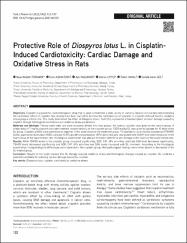| dc.contributor.author | Türkmen, Neşe Başak | |
| dc.contributor.author | Özek, Dilek Aşkın | |
| dc.contributor.author | Taşlıdere, Aslı | |
| dc.contributor.author | Çiftçi, Osman | |
| dc.contributor.author | Saral, Özlem | |
| dc.contributor.author | Gül, Cemile Ceren | |
| dc.date.accessioned | 2022-11-21T10:33:28Z | |
| dc.date.available | 2022-11-21T10:33:28Z | |
| dc.date.issued | 2022 | en_US |
| dc.identifier.citation | Başak Türkmen, N., Aşkın Özek, D., Taşlıdere, A., Çiftçi, O., Saral, Ö., & Gül, C. C. (2022). Protective Role of Diospyros lotus L. in Cisplatin-Induced Cardiotoxicity: Cardiac Damage and Oxidative Stress in Rats. Turkish journal of pharmaceutical sciences, 19(2), 132–137. https://doi.org/10.4274/tjps.galenos.2021.84555 | en_US |
| dc.identifier.issn | 1304-530X | |
| dc.identifier.issn | 2148-6247 | |
| dc.identifier.uri | https://doi.org/10.4274/tjps.galenos.2021.84555 | |
| dc.identifier.uri | https://hdl.handle.net/11436/7097 | |
| dc.description.abstract | Objectives: Cisplatin is a powerful chemotherapeutic drug that is used to treatment a wide variety of cancers. Despite clinical data demonstrating the cardiotoxic effect of cisplatin, few studies have been carried to improve the cardiotoxicity of cisplatin. In cisplatin-induced toxicity, oxidative stress plays a critical role. This study determined the effect of Diospyros lotus L. fruit (DL), a powerful antioxidant plant, on heart damage caused by cisplatin through histological examination and oxidative stress parameters.
Materials and Methods: Twenty eight male rats were randomly divided into four groups. An isotonic solution was given to the control group. A single dose of 7 mg/kg cisplatin was administered intraperitoneally to the cisplatin group. 1.000 mg/kg DL was given by gavage for 10 days to the DL group. Cisplatin and DL were administered together in the same doses to the treatment group. Thiobarbituric acid reactive substances (TBARS) levels, superoxide dismutase (SOD), catalase (CAT), glutathione peroxidase (GPx) activities, and total glutathione (GSH) level were measured in the heart tissue of the experimental rats. Histological examination was also performed to determine any damage to the hearts of the experimental rats.
Results: While TBARS levels in the cisplatin group increased significantly, SOD, CAT, GPx activities, and total GSH level decreased significantly. TBARS levels decreased significantly and SOD, CAT, GPx activities and GSH levels increased with DL treatment. According to the histological examination, histopathological differences were observed in the cisplatin group. Histopathological findings were either absent or decreased in the DL-treated group.
Conclusion: Results of the study showed that DL therapy reduced oxidative stress and histological changes caused by cisplatin. DL could be a potential candidate for reducing cardiac damage caused by cisplatin. | en_US |
| dc.language.iso | eng | en_US |
| dc.publisher | Galenos Yayıncılık | en_US |
| dc.rights | info:eu-repo/semantics/openAccess | en_US |
| dc.subject | Diospyros lotus | en_US |
| dc.subject | Cisplatin | en_US |
| dc.subject | Cardiotoxicity | en_US |
| dc.subject | Oxidative stress | en_US |
| dc.title | Protective role of diospyros lotus l. in cisplatin-induced cardiotoxicity: Cardiac damage and oxidative stress in rats | en_US |
| dc.type | article | en_US |
| dc.contributor.department | RTEÜ, Sağlık Yüksekokulu, Beslenme ve Diyetetik Bölümü | en_US |
| dc.contributor.institutionauthor | Saral, Özlem | |
| dc.identifier.doi | 10.4274/tjps.galenos.2021.84555 | en_US |
| dc.identifier.volume | 19 | en_US |
| dc.identifier.issue | 2 | en_US |
| dc.identifier.startpage | 132 | en_US |
| dc.identifier.endpage | 137 | en_US |
| dc.relation.journal | Turkish Journal of Pharmaceutical Science | en_US |
| dc.relation.publicationcategory | Makale - Uluslararası Hakemli Dergi - Kurum Öğretim Elemanı | en_US |


















